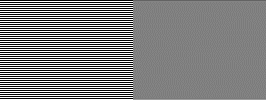|
|
This topic comprises 5 pages: 1 2 3 4 5
|
|
Author
|
Topic: Comparison of digital formats
|
|
|
Evans A Criswell
Phenomenal Film Handler

Posts: 1579
From: Huntsville, AL, USA
Registered: Mar 2000
|
 posted 06-13-2001 09:32 AM
posted 06-13-2001 09:32 AM





I disagree with the comparisons in the first HTML page. The comparisons are OK, but I feel that some of the resolution figures are a bit misleading. All NTSC formats have information on 525 scan lines, of which 480 are used. This means that there are 480 scan lines of information on DVD, Laserdisc, VHS, Super VHS, or any other NTSC format that encodes all scan lines.Laserdisc, VHS, Super VHS, and other analog formats do not have "pixels", so speaking of the aspect ratio of "pixels" is inappropriate in those cases. These formats have 480 (or 483 as some sources say) visible scan lines, and what varies, resolution-wise, is the amount of information that can be encoded on each scan line based on the bandwidth limitations of the media and/or recording and playback devices. While the 480 scan lines are interlaced, all of the sources mentioned above could be run through a line doubler which could take advantage of the 3:2 pulldown method of recording movies on those media and get the full 480 scan lines of information wihtout the scan line overlap that causes some apparent loss of resolution. Therefore, all of the resolution figures for all these media should be something by 480, unless some format doesn't actually encode all the scan lines (CDi?)? Another consideration when comparing formats is whether the format is composite or whether the color and brightness information are stored separately without interference. DVD and S-VHS store color and brightness separately, meaning that if an S-Video cable is used, the artifacts created by separating those elements in a composite signal can be avoided. VHS actually stores color and brightness separately, but only S-VHS players tend to have S-Video outs, and the color and brightness signals interfere on VHS (a problem solved by moving the luminace signal to a higher frequency carrier for S-VHS). Laserdisc is composite, meaning that those elements must be separated, so that those artifacts are unavoidable. (Use S-Video cable with laserdisc if laserdisc player hgas better comb filter, and use composite cable if TV has better comb filter). With DVD or S-VHS, use an S-Video cable, always (or component with DVD if possible). There is more to the comparisons than simple resolution comparisons. If a format came out that had a 1024x480 resolution, but was composite, DVD's component encoding at 720x480 would likely produce a better picture. Then there's the color portion of the signal. What is the bandwidth of the color signal in each format? Resulution figures quoted are typically for the luminance portion. See how many alternating fully saturated, full luminance red and black transitions you can record on a scan line on plain VHS.  DVD is clearly the winner, with 720x480 resolution. Comparing Laserdisc with S-VHS is a bit trickier, though. There is more to the comparison than meets the eye. ------------------
Evans A Criswell
Huntsville-Decatur Movie Theatre Info Site
| IP: Logged
|
|
|
|
|
|
|
|
|
|
|
|
|
|
Jonathan Haglund
Film Handler
Posts: 81
From: Irvine, CA, USA
Registered: Apr 2001
|
 posted 06-14-2001 03:12 AM
posted 06-14-2001 03:12 AM





Something I've wondered: What improvements does MPEG-4 have over MPEG-2?Also, ever wonder whats in store for the next gen of TiVo's? Click here -Jonathan
| IP: Logged
|
|
|
|
Evans A Criswell
Phenomenal Film Handler

Posts: 1579
From: Huntsville, AL, USA
Registered: Mar 2000
|
 posted 06-14-2001 09:31 AM
posted 06-14-2001 09:31 AM





Peter, the trick would be to store the data in such a manner that common types of film wear (like vertical scratches, which I suspect would be the most common type of data loss) would not wipe out data. There would need to be redundancy in the data. It could definitely be done, but getting such a format to become an accepted standard would be a challenge.And whether the information that makes up a 35mm film (picture and sound) could be compressed and stored somehow digitally on 8mm film (or any other media, for that matter) depends on entropy (amount of information present) and how much loss is acceptable before the human visual and hearing systems notice degradation. I suspect that this type of digitizing could be done with satisfactory results using lossy compression. It is difficult to even attempt to calculate the "digital bandwidth" of any type of film because the resultion figures I see for film varies depending on the information source. It's a question of how many bits of information could be stored on the film in the form of a rectangular array of "values" in the form of brighter and darker square pixels. For example, if only two brightness values (white and black) are used, how "fine" can the packing of these squares be on the film to be read reliably with a very low error rate? Factor in some redundancy to allow correction of some read errors. It may be better to use more brightness values (several shades of gray, depending on the approach used in building the reader. Once a bandwidth (so many megabits per second) is determined, then it could be determined what resolution could be achieved for picture and sound using current available technology and compression methods. John Pytlak is probably familiar with the recording of digital data on film, and what resolutions are used (how many quantization levels are used per unit, and at what density the units are stored on film). If so, John (or anyone else in the know), please chime in! 
------------------
Evans A Criswell
Huntsville-Decatur Movie Theatre Info Site
| IP: Logged
|
|
|
|
Peter Berrett
Jedi Master Film Handler

Posts: 602
From: Victoria, Australia
Registered: Nov 2000
|
 posted 06-15-2001 05:42 AM
posted 06-15-2001 05:42 AM





I also found the following link which does a comparison between the storage capacity of one form of film and digital mediums.
http://www.igraph.com/ebr_whyfilm.htm "EBIR FILM AND OTHER STORAGE MEDIA COMPARISONS Electron beam recording of imagery on film also has specific advantages over recording on magnetic and optical storage media.
A terabyte of uncompressed data can be recorded on a single roll of 9.5" film 235’ long with the EBIR, compared to recording
on 200 exabyte tapes or 217 (4.6 gigabyte) optical disks. The time to record a terabyte of data with an EBIR is 14 hours
compared to 70 hours using exabyte tapes and 275 hours using 4.6 gigabyte optical disks. The volume of space required to store 1 terabyte of data on a 9.5" roll of film is only 0.1 cubic feet compared to 0.9 cubic feet
of exabyte tapes and 1.6 cubic feet of 4.6 gigabyte optical disks. This volume does include any mechanical mechanism for
storing and retrieving the media i.e. optical jukeboxes, magnetic tape drives, etc. The cost of the media for storing a terabyte of data on exabyte tape is 2.8 times higher and optical disk is 35 times higher than
EBIR film. Another advantage of film, is that the film is archival and its images may be viewed at any time in the future (hundreds of years)
using optical readers. Film is not subject to explosive technology changes causing obsolescence of digital reading equipment for
image data retrieval."
9.5' = does this mean 9.5mm? cheers Peter
| IP: Logged
|
|
Aaron Haney
Master Film Handler
Posts: 265
From: Cupertino, CA, USA
Registered: Jan 2001
|
 posted 06-16-2001 09:08 PM
posted 06-16-2001 09:08 PM




quote:
Evans wrote:I disagree with the comparisons in the first HTML page. The comparisons are OK, but I feel that some of the resolution figures are a bit misleading. All NTSC formats have information on 525 scan lines, of which 480 are used. This means that there are 480 scan lines of information on DVD, Laserdisc, VHS, Super VHS, or any other NTSC format that encodes all scan lines.
That's something that has always confused me, too. NTSC is a 525 (480 active) line format, yet people always refer to VHS as "about 240 lines resolution", and present similar numbers for other formats (300 for laserdisc, 330 for broadcast, 400 for S-VHS, etc.). A quick search revealed a couple of webpages that attempt to explain this difference, but neither explanation is entirely satisfactory: http://www.questronix.com.au/html/info_resolution.htm
http://www.elitevideo.com/new2.htm Reading those links helped, but I still don't quite understand how an analog video signal can have less than the number of lines in the NTSC standard. If I could just find a source that gave a full explanation (not watered-down) that would help immensely. Anyone have any suggestions?
| IP: Logged
|
|
Adam Martin
I'm not even gonna point out the irony.

Posts: 3686
From: Dallas, TX
Registered: Nov 2000
|
 posted 06-17-2001 09:52 AM
posted 06-17-2001 09:52 AM




Here's a crude example. Say you have a "box" and that box has a resolution of 133x100. It can reproduce an image made up of 100 lines. If you have source material of 200 lines, the box will still try to reproduce it, but the 200 lines will blur together to match the 100 lines of resolution that the box limits it to.  In the example above, the left box has a source material of 100 lines. The right box has a source material of 200 lines, but the box's limit is 100 lines and the image blurs together. If you have an image of 525 lines of NTSC and store it on VHS tape, the tape's (horizontal) resolution limit is about 240 lines, so the image becomes blurred together. When you go to play that tape on your TV, even though the TV can reproduce 525 lines (480 visible), the source (the tape) is only 240 lines and looks blurry on TV. Therefore, the better the resolution of your storage media (tape, DVD, etc.) the sharper the picture will appear when it is reproduced. Incidentally, optics have a resolution, too. You can run a test loop on a film projector and see how close the lines on the screen can get before they blur together. And have you ever had an eye exam with a chart (you know, with the big E on top)? You're checking the "resolution" of your eyes. Hope this helps. If not, I can try again. 
| IP: Logged
|
|
|
|
All times are Central (GMT -6:00)
|
This topic comprises 5 pages: 1 2 3 4 5
|
Powered by Infopop Corporation
UBB.classicTM
6.3.1.2
The Film-Tech Forums are designed for various members related to the cinema industry to express their opinions, viewpoints and testimonials on various products, services and events based upon speculation, personal knowledge and factual information through use, therefore all views represented here allow no liability upon the publishers of this web site and the owners of said views assume no liability for any ill will resulting from these postings. The posts made here are for educational as well as entertainment purposes and as such anyone viewing this portion of the website must accept these views as statements of the author of that opinion
and agrees to release the authors from any and all liability.
|

 Home
Home
 Products
Products
 Store
Store
 Forum
Forum
 Warehouse
Warehouse
 Contact Us
Contact Us




 Printer-friendly view of this topic
Printer-friendly view of this topic















